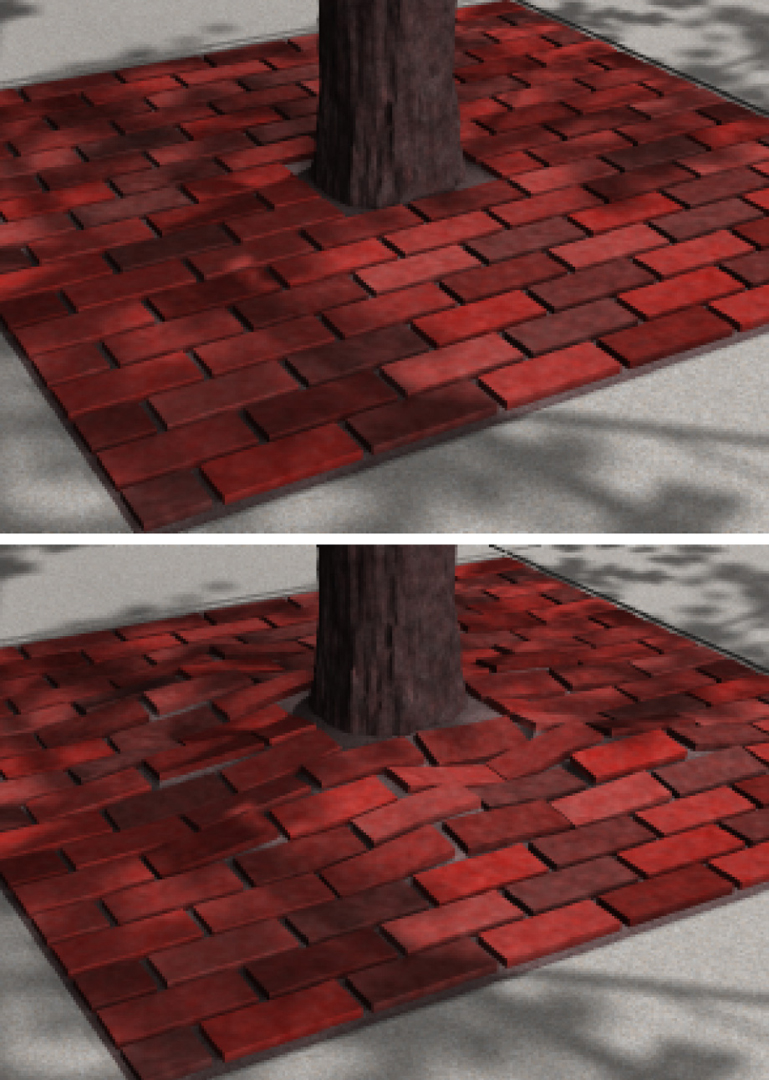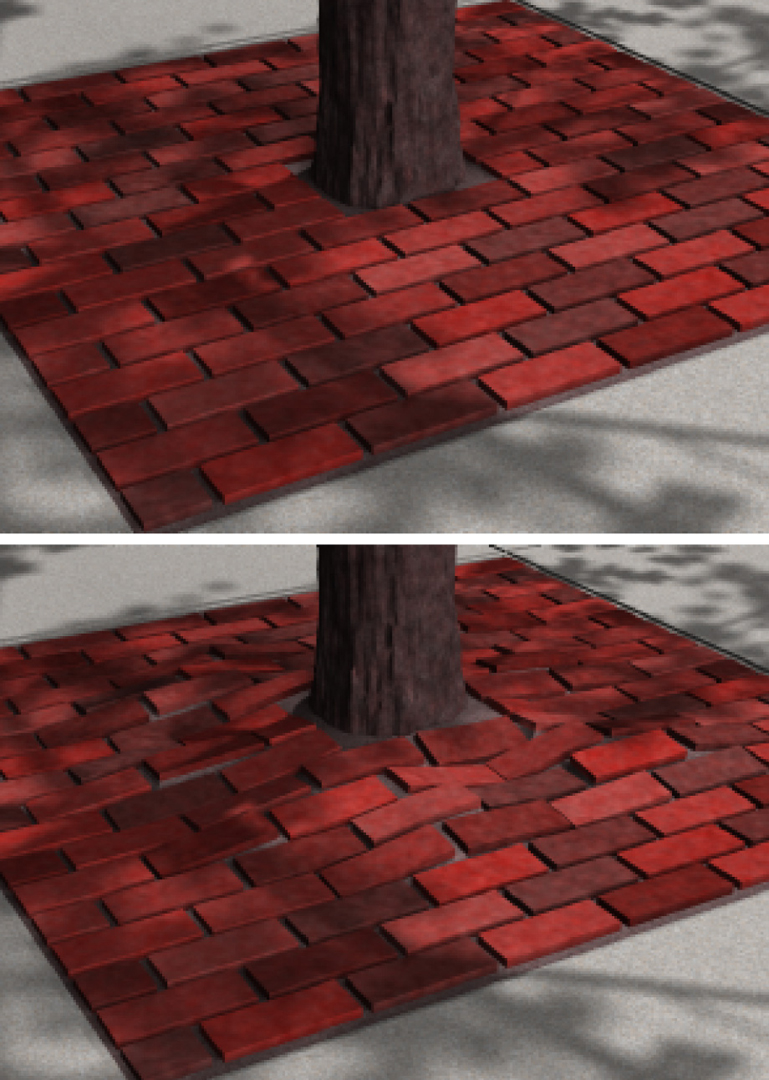“A procedural approach to authoring solid models”
Conference:
Type(s):
Title:
- A procedural approach to authoring solid models
Presenter(s)/Author(s):
Abstract:
We present a procedural approach to authoring layered, solid models. Using a simple scripting language, we define the internal structure of a volume from one or more input meshes. Sculpting and simulation operators are applied within the context of the language to shape and modify the model. Our framework treats simulation as a modeling operator rather than simply as a tool for animation, thereby suggesting a new paradigm for modeling as well as a new level of abstraction for interacting with simulation environments.Capturing real-world effects with standard modeling techniques is extremely challenging. Our key contribution is a concise procedural approach for seamlessly building and modifying complex solid geometry. We present an implementation of our language using a flexible tetrahedral representation. We show a variety of complex objects modeled in our system using tools that interface with finite element method and particle system simulations.
References:
1. ADZHIEV, V., CARTWRIGHT, R., FAUSETT, E., OSSIPOV, A., PASKO, A., AND SAVCHENKO, V. 1999. HyperFun Project: A framework for collaborative multi-dimensional F-rep modeling. In Proceedings of Implicit Surfaces ’99, 59-69.Google Scholar
2. ANDERSON, H. L., Ed. 1989. A Physicist’s Desk Reference, 2nd ed. American Institute of Physics, New York.Google Scholar
3. BAKER, T. J. 1989. Automatic mesh generation for complex three-dimensional regions using a constrained delaunay triangulation. Engineering with Computers, 5, 161-175.Google Scholar
4. BLOOMENTHAL, J., AND FERGUSON, K. 1995. Polygonization of non-manifold implicit surfaces. In Proceedings of ACM SIGGRAPH 95, Computer Graphics Proceedings, Annual Conference Series, 309-316. Google Scholar
5. BLOOMENTHAL, J, 1994. An implicit surface polygonizer. In Graphics Gems IV. Academic Press, Boston, 324-349. Google Scholar
6. CIGNONI, P., COSTANZA, D., MONTANI, C., ROCCHINI, C., AND SCOPIGNO, R. 2000. Simplification of tetrahedral meshes with accurate error evaluation. In IEEE Visualization 2000, 85-92. Google Scholar
7. COOK, R. L. 1984. Shade trees. In Computer Graphics (Proceedings of ACM SIGGRAPH 84), 18(3), 223-231. Google Scholar
8. COQUILLART, S. 1990. Extended free-form deformation: A sculpturing tool for 3d geometric modeling. In Computer Graphics (Proceedings of SIGGRAPH 90), 24(4), 187-196. Google Scholar
9. DORSEY, J., PEDERSEN, H. K., AND HANRAHAN, P. M. 1996. Flow and changes in appearance. In Proceedings of ACM SIGGRAPH 96, Computer Graphics Proceedings, Annual Conference Series, 411-420. Google Scholar
10. DORSEY, J., EDELMAN, A., LEGAKIS, J., JENSEN, H. W., AND PEDERSEN, H. K. 1999. Modeling and rendering of weathered stone. In Proceedings of ACM SIGGRAPH 99, Computer Graphics Proceedings, Annual Conference Series, 225-234. Google Scholar
11. EBERT, D. S., MUSGRAVE, F. K., PEACHEY, D., PERLIN, K., AND WORLEY, S. 1998. Texturing & Modeling, 2nd ed. Academic Press. Google Scholar
12. FLEISCHMANN, P., KOSIK, R., HAINDL, B., AND SLBERHERR, S. 1999. Simple examples to illustrate specific finite element mesh requirements. In Proceedings of the 8th International Meshing Roundtable, 241-246.Google Scholar
13. FREITAG, L. A., AND OLLIVIER-GOOCH, C. 1997. Tetrahedral mesh improvement using swapping and smoothing. International Journal for Numerical Methods in Engineering, vol. 40, 3979-4002.Google Scholar
14. FRISKEN, S. F., PERRY, R. N., ROCKWOOD, A. P., AND JONES, T. R. 2000. Adaptively sampled distance fields: A general representation of shape for computer graphics. In Proceedings of ACM SIGGRAPH 2000, Computer Graphics Proceedings, Annual Conference Series, 249-254. Google Scholar
15. GARLAND, M., AND HECKBERT, P. S. 1997. Surface simplification using quadric error metrics. In Proceedings of ACM SIGGRAPH 97, Computer Graphics Proceedings, Annual Conference Series, 209-216. Google Scholar
16. HANRAHAN, P., AND LAWSON, J. 1990. A language for shading and lighting calculations. In Computer Graphics (Proceedings of ACM SIGGRAPH 90), 24(4), 289-298. Google Scholar
17. HOPPE, H. 1996. Progressive meshes. In Proceedings of ACM SIGGRAPH 96, Computer Graphics Proceedings, Annual Conference Series, 99-108. Google Scholar
18. LEGAKIS, J., DORSEY, J., AND GORTLER, S. J. 2001. Feature-based cellular texturing for architectural models. In Proceedings of ACM SIGGRAPH 2001, Computer Graphics Proceedings, Annual Conference Series, 309-316. Google Scholar
19. LOHNER, R. 1988. Generation of three-dimensional unstructured grids by the advancing front method. In International Journal for Numerical Methods in Fluids, vol. 8, 1135-1149.Google Scholar
20. LORENSEN, W. E., AND CLINE, H. E. 1987. Marching cubes: A high resolution 3d surface construction algorithm. In Computer Graphics (Proceedings of ACM SIGGRAPH 87), 21(4), 163-169. Google Scholar
21. MIZUNO, S., OKADA, M., AND ICHIRO TORIWAKI, J. 1998. Virtual sculpting and virtual woodcut printing. The Visual Computer, 14(2), 39-51.Google Scholar
22. MÜLLER, M., DORSEY, J., MCMILLAN, L., AND JAGNOW, R. 2001. Real-time simulation of deformation and fracture of stiff materials. In Proceedings of Eurographics Workshop on Animation and Simulation 2001, 113-124. Google Scholar
23. NIELSON, G. M., AND SUNG, J. 1997. Interval volume tetrahedrization. In IEEE Visualization ’97, 221-228. Google Scholar
24. NOORUDDIN, F. S., AND TURK, G. 2000. Interior/exterior classification of polygonal models. In IEEE Visualization 2000, 415-422. Google Scholar
25. O’BRIEN, J. F., AND HODGINS, J. K. 1999. Graphical modeling and animation of brittle fracture. In Proceedings of ACM SIGGRAPH 99, Computer Graphics Proceedings, Annual Conference Series, 137-146. Google Scholar
26. PARISH, Y. I. H., AND MÜLLER, P. 2001. Procedural modeling of cities. In Proceedings of ACM SIGGRAPH 2001, Computer Graphics Proceedings, Annual Conference Series, 301-308. Google Scholar
27. PAYNE, B. A., AND TOGA, A. W. 1992. Distance field manipulation of surface models. IEEE Computer Graphics & Applications, 12(1), 65-71. Google Scholar
28. PERLIN, K., AND HOFFERT, E. M. 1989. Hypertexture. In Computer Graphics (Proceedings of ACM SIGGRAPH 89), 23(3), 253-262. Google Scholar
29. PERLIN, K. 1985. An image synthesizer. In Computer Graphics (Proceedings of ACM SIGGRAPH 85), 19(3), 287-296. Google Scholar
30. PRUSINKIEWICZ, P., LINDENMAYER, A., AND HANAN, J. 1988. Developmental models of herbaceous plants for computer imagery purposes. In Computer Graphics (Proceedings of ACM SIGGRAPH 88), 22(4), 141-150. Google Scholar
31. RAVIV, A., AND ELBER, G. 2000. Three-dimensional freeform sculpting via zero sets of scalar trivariate functions. Computer-Aided Design, 32(8-9), 513-526.Google Scholar
32. RICCI, A. 1973. A constructive geometry for computer graphics. The Computer Journal, 16(2), 157-160.Google Scholar
33. SETHIAN, J. A. 1999. Level Set Methods and Fast Marching Methods, 2nd ed. Cambridge University Press, Cambridge, United Kingdom. Google Scholar
34. SHEWCHUK, J. R. 1998. Tetrahedral mesh generation by delaunay refinement. In Proceedings of the 14th Annual Symposium on Computational Geometry, 86-95. Google Scholar
35. STAADT, O. G., AND GROSS, M. H. 1998. Progressive tetrahedralizations. In IEEE Visualization ’98, 397-402. Google Scholar
36. TROTTS, I. J., HAMANN, B., AND JOY, K. I. 1999. Simplification of tetrahedral meshes with error bounds. IEEE Transactions on Visualization and Computer Graphics, 5(3), 224-237. Google Scholar
37. UPSTILL, S. 1990. The Renderman Companion: A Programmer’s Guide to Realistic Computer Graphics. Addison-Wesley. Google Scholar
38. WANG, S. W., AND KAUFMAN, A. E. 1995. Volume sculpting. In Symposium on Interactive 3D Graphics, ACM Press, 151-156. Google Scholar
39. WYVILL, B., MCPHEETERS, C., AND WYVILL, G. 1986. Data structure for soft objects. The Visual Computer, 2(4), 227-234.Google Scholar
40. WYVILL, B., GUY, A., AND GALIN, E. 1999. Extending the CSG tree. Warping, blending and boolean operations in an implicit surface modeling system. Computer Graphics Forum, 18(2), 149-158.Google Scholar
41. YERRY, M. A., AND SHEPHARD, M. S. 1984. Automatic three-dimensional mesh generation by the modified octree technique. International Journal For Numerical Methods in Engineering, 20, 1965-1990.Google Scholar






